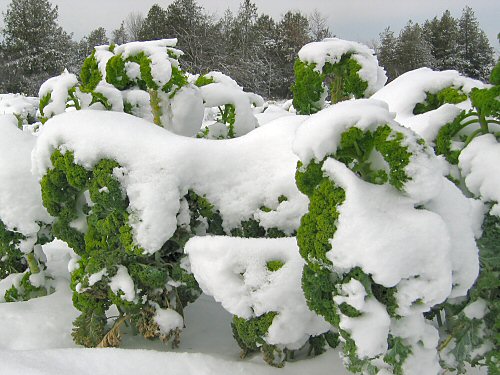
Another installment in the snow-covered series: Winterbor kale! I’m so used to rollercoaster weather and the new winters that never really get started, it’s kind of a shock to have this much snow for three days in a row in November. And there’s no melt-off in sight, with the 15-day forecast predicting little sun and day temperatures hovering under 0°C (32°F). Picked a few pounds of the kale today, it’s still holding up, particularly the young new growth. It won’t last long if it stays frozen day and night. All this watching of cold-weather crops is bound to come in handy…sometime!




I’ve heard that kale and other greens will survive snow. I’m living down in Tennessee where we don’t get too much snow, but we will get freezing weather in January and February. I have mustard and collards which are growing quite well even with freezing temperatures periodically at night. How many days of continuous freezing temperatures do you think the kale could stand up their in Canada?
Mike, I’m so jealous of all of your snow! We’ve got nothing here- just cold!
Anne: Well, it seems to depend. From observation, kale is the hardiest, and for all of the hardy stuff, including various brassicas, spinach, chard, some of the herbs, how long they last seems to depend on how long they stay frozen (if they thaw every day or stay frozen for a while, staying frozen is not good), plus wind (it definitely damages cold plants). There’s a pattern, but it’s not straightforward, no rule like, go below a certain temperature and it’s toast. Most just go from OK to not good at all (leaves are yellowish, texture changes, they’re mushy), but kale can degrade in stages. I picked some yesterday, and some of the leaves are getting kinda yellow (drying out), but they’re overall still great. I can’t really generalize based only on what I’ve seen…
I got more curious about all this last night, and decided to go the farmer-scientist route and see what I could find. A search for “plant physiology freezing” scored two interesting hits in a couple of minutes, one off Google’s first 10 results, one off of Yahoo’s. They’re both…readable (I have no sciences background…)!
Basically, the keyword is SUPERCOOLING. This puts a term and a concept to what I’ve observed. Essentially, water can go well below its minimum freezing point without turning to ice. It can freeze at 0°C, but also supercool—”stay liquid”—to around -40°C, at which point, crystallization is for sure. In hardy plants, no ice crystals, no damage. It’s a little more involved than that, there’s more interesting stuff, like intercellular and intracellular freezing, generated heat and dehydration, and I’m not sure if KNOWING that will somehow help in the field. But it’s a cool explanation, and all makes sense when you’re thinking about the garden. The more you know, the less you need….?
Anyhow, if you like, read all about it: Role of Cold-Responsive Genes in Plant Freezing Tolerance (first three short introductory sections, then it gets all technical and into genetics…) and Ice Formation in Higher-Plant Cells. Fun!
Amanda: Mmmm, yeah, lovely snow… Maybe for the Holidays. Really, though, for now I’d rather be able to go out there and get the rest of the carrots! :)
Thanks Mike. That is some interesting reading. I’m not too much of a scientist either except in the hands-on farmer kind of way. I’m interested to see how the greens do this winter. Good Luck to you.
Hello!
Question for you – once the kale is snowed on/frozen once, do I still need to blanche then freeze it or can I just freeze it as is? I’m uncertain if I even CAN freeze it…but it’s already been frozen! Please help clear my confusion if you can.
Cheers,
Erikka
You should experiment. Blanching veggies in general is the usual way to go, but you can also get surprisingly good results just tossing veggies directly into the freezer.
With kale, it’s hard to say whether it’s actually been frozen while still alive in the subzero field! Some of these cold-hardy veggies may be set up so the internal water gets really cold, but doesn’t actually crystallize (see SUPERCOOLING in my comment above). You’d think some scientist in a lab somewhere would’ve tried this, but it’s not easy info to discover.
Anyhow, the simple answer is, TRY IT. Grab a few leaves and toss ’em in the freezer. Maybe blanche-and-freeze some as well. In a day or two, you’ll be well on your way to new knowledge! :)
Hope that helps!